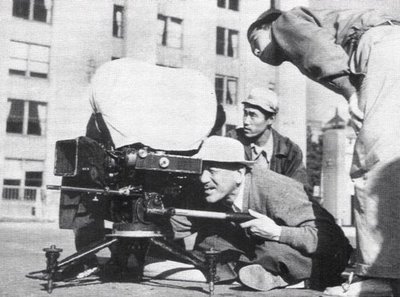| architecture |
| calligraphy |
| ceramics |
| clothing |
| comics |
| gardens |
| lacquerwork |
| literature |
| movies |
| music |
| painting |
| poetry |
| sculpture |
| tea ceremony |
| television |
| theatre |
| weaponry |
| thematic routes |
| timeline |
| the site |
context: movies > directors > Ozu
Yasujiro Ozu, Experimental Director?

|
Ozu showing how he gets those camera positions |
Bordwell makes a good case for regarding Ozu as an experimental director, regarding his persistently low camera position and eventual elimination of camera movement as arbitrary restrictions of an almost Oulipo kind. Certainly Ozu's own explanations of this were patently false and apparently playful. He goes on to describe various methods used by Ozu that do not fit within these rules or cinematic norms, and don't have a narrative function, citing these as playfulness and poetry within his strictures, parallelling this astutely with Japan's history of art as a game, particularly in what was done within very rigid poetic formats.
The famous low camera position: this removes the lines of tatami mats, and rarely includes ceilings - so we lose recessional horizontal planes and their concomitant insistence on depth. Ozu believed in delivering one piece of information per shot, and this may have helped that. This was NOT the position of a seated person or a child, as is often claimed - he films from around 1/2 to 2/3 up the main subject, whether a standing or sitting adult or child - or even, at times, a building. Note that this position, which can almost never be reasonably interpreted as that of an invisible observer, helps to foreground the awareness that we are seeing an artistic presentation.
sideways: presentation vs representation
backwards: zen?
